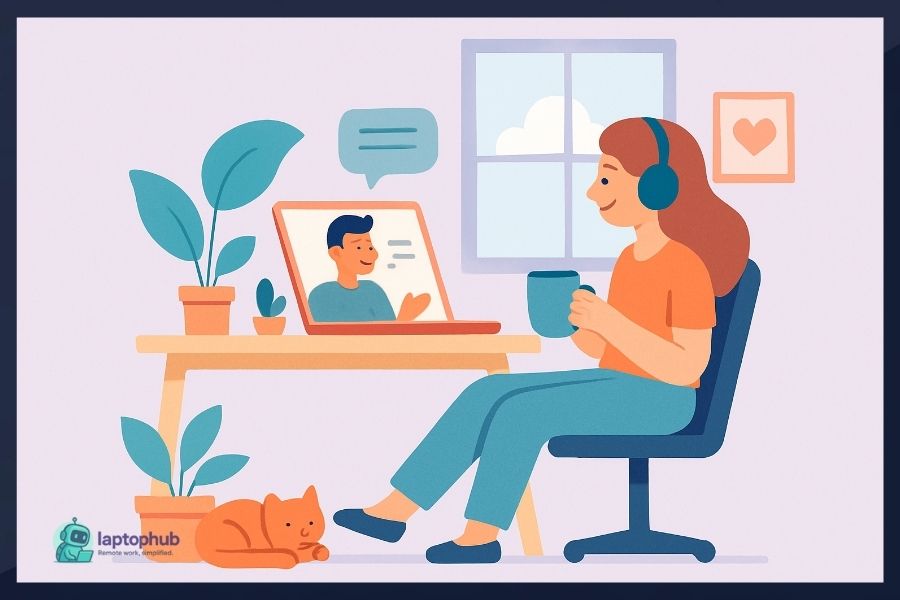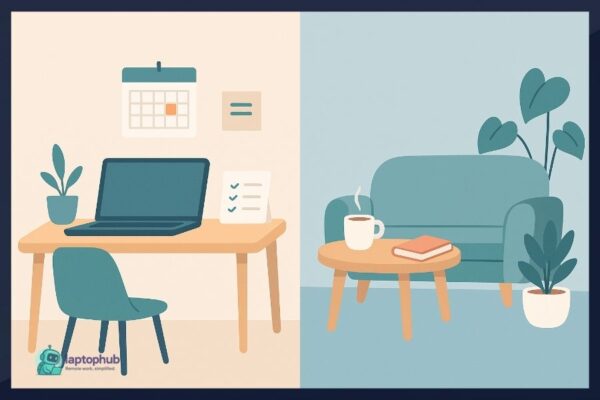Working from home used to sound like freedom: no traffic, no dress code, no office politics. But when the buzz wears off, many of us are left facing something we didn’t expect—silence, solitude, and a growing sense of disconnection. The freedom of remote work can quietly morph into isolation if we’re not careful. The good news? It doesn’t have to stay that way.
The truth is, loneliness while working from home is more common than most people admit. It’s not just about missing coworkers; it’s about losing those small, daily interactions that remind us we’re part of something bigger. Over the years, I’ve learned how to manage this. It takes intention and effort, but it’s absolutely possible to feel connected while working solo.
Here’s what’s worked for me and could work for you too
💡Key takeaways:
- Building intentional structure into your daily routine helps reduce feelings of isolation.
- Regular human interaction—online or offline—is crucial to combat loneliness while working remotely.
- Physical movement and environment boundaries play a major role in maintaining emotional well-being.
- Loneliness is normal for remote workers, but actionable steps and support systems can make it manageable.
1. Build Structure Into Your Day
One of the fastest paths to loneliness is lack of structure. When your schedule is too open, it’s easy to spiral into distraction or overwork—both of which increase feelings of isolation.
I start my day the same way every morning: get up, shower, make coffee, then start work at a set time. I block my calendar with work sessions, lunch, exercise, and even downtime. Having a defined rhythm gives my day purpose and cuts down on that aimless, floaty feeling that can fuel loneliness.
If you’re not sure where to start, use time-blocking or a simple planner app. Creating a structure doesn’t mean you lose freedom—it means you take control of your time.
2. Get Out of the House Daily
Even if it’s just a 10-minute walk, leaving the house is non-negotiable. I used to go two or three days without stepping outside, thinking I was being productive. In reality, it was tanking my mood.
Fresh air, sunlight, and seeing other people—even if you don’t talk to them—remind your brain you’re part of the world. I take walks, work from a coffee shop a few times a week, or run errands just to interact with someone face-to-face.
To build consistency, schedule your outdoor time like any other meeting. It’s an appointment with your sanity.
3. Join Online Communities That Aren’t Just About Work
Slack groups, Discord channels, LinkedIn groups—there’s a community for nearly every interest. I joined a couple of groups for remote workers and freelancers. We share memes, wins, struggles, and check in on each other.
It’s not the same as being in an office, but it helps me feel seen. These small interactions go a long way in making me feel less alone in the day-to-day.
Look for groups that align with your hobbies too—gaming, parenting, books, fitness. Shared interests build real connections beyond just “what do you do for work?”
4. Schedule Real Conversations
Texting and DMs aren’t enough. We need real conversations.
I started scheduling weekly calls with friends who also work remotely. Nothing formal, just a 15- or 30-minute catch-up. We talk about work, life, and whatever’s going on. It’s something I look forward to, and it breaks up the silence of the workday.
If you don’t have anyone to do that with yet, start small. Reach out to an old colleague, join a mastermind group, or say yes to a virtual coffee chat. Real voices matter.
Pro tip: Use calendar invites to lock these chats in. Treat them like important meetings—because they are.
5. Co-Work Virtually
This one changed the game for me. I found a few accountability buddies and started hosting virtual co-working sessions. We hop on Zoom, say a quick hello, mute ourselves, and work in parallel.
It sounds simple, but having someone “there” with you helps recreate the vibe of an office. You get the motivation of shared energy without the distraction.
There are also platforms built just for this—Focusmate, Flow Club, Caveday. Try one out.
6. Don’t Work Where You Sleep
For a while, my bed doubled as my desk. It was convenient, but it blurred all the lines. I’d start working the moment I woke up and check emails at midnight. The result? Burnout and a deep sense of disconnect.
Now, I have a separate workspace. It doesn’t have to be a full home office—even a designated corner with a desk and chair makes a huge difference. When I leave that space, I feel like I’m “off the clock.”
Creating physical boundaries helps reinforce mental boundaries, which is key to reducing loneliness.
7. Take Advantage of Flexibility—Intentionally
Remote work gives you flexibility. Use it.
I started scheduling meetups during off-hours: a lunch with a friend on a Wednesday, a morning yoga class, a mid-day grocery run when stores are quiet. These little social boosts make the work-from-home lifestyle feel like a choice, not a sentence.
If you’re chained to your desk all day every day, you’re missing the upside of remote life. Give yourself space to be human.
8. Prioritize Movement
Loneliness and stagnation go hand-in-hand. When I don’t move my body, my mind spirals. It’s just how it is.
You don’t need to become a fitness junkie. But a daily walk, stretch break, or 20-minute YouTube workout can shift your entire mood. I treat movement like medicine: not optional, always effective.
Group fitness classes—in-person or virtual—also add a layer of social connection, even if you’re not talking to anyone.
9. Add a Personal Ritual to Your Day
Rituals help ground your routine. I light a candle before I start work, and close my laptop while playing a specific song at the end of the day. These small acts create a mental “on” and “off” switch.
It sounds minor, but it adds a sense of control and rhythm—and when you’re feeling lonely or aimless, that predictability can feel like an anchor.
10. Acknowledge It’s Normal
The worst part of feeling lonely is thinking you’re the only one.
You’re not. Loneliness is one of the most common struggles for remote workers. It doesn’t mean you’re broken or doing something wrong. It means you’re human.
Once I started talking about it with other people, the shame lifted. I realized many others felt the same way but didn’t know how to bring it up.
Normalize the conversation. It helps.
11. Consider Therapy or Coaching
Sometimes, the loneliness digs deeper than routines and video calls can fix. When that happened to me, I reached out to a therapist who helped me unpack what was really going on.
There’s no shame in needing help. In fact, remote work makes it easier than ever to access therapy or coaching online. If you’re feeling chronically isolated, anxious, or stuck, talk to someone. You don’t have to carry it alone.
Platforms like BetterHelp, Talkspace, or local telehealth providers offer flexible options. Investing in your mental health is one of the best decisions you can make.
FAQs
Is it normal to feel lonely when working from home?
Yes, many remote workers experience loneliness due to reduced social interaction and lack of routine. It’s a common but manageable challenge.
What are the best ways to stay social while working remotely?
Join online communities, schedule real-time conversations, and try virtual co-working sessions to maintain human connection.
Can working from home affect my mental health?
Yes, isolation and lack of structure can lead to burnout or depression. Building routines, staying active, and seeking help when needed are essential.
How can I separate work from personal life at home?
Create a dedicated workspace and establish clear start and stop rituals to mentally transition in and out of work mode.
Are there tools or platforms that help with remote work loneliness?
Yes—tools like Focusmate, Slack communities, and online therapy platforms can help build connection and support.
Final Thoughts
Working from home has huge upsides, but it comes with trade-offs. Loneliness is one of them. But the good news is, it’s solvable. With the right habits, connections, and mindset, you can feel connected and grounded even while working solo.
You don’t need to overhaul your life overnight. Just pick one thing to try this week. Maybe it’s a walk or a virtual co-work session. Maybe it’s finally messaging that friend you keep meaning to call.
Loneliness doesn’t have to be part of the job. You can work from home and still feel fully human. I’m proof of that.


